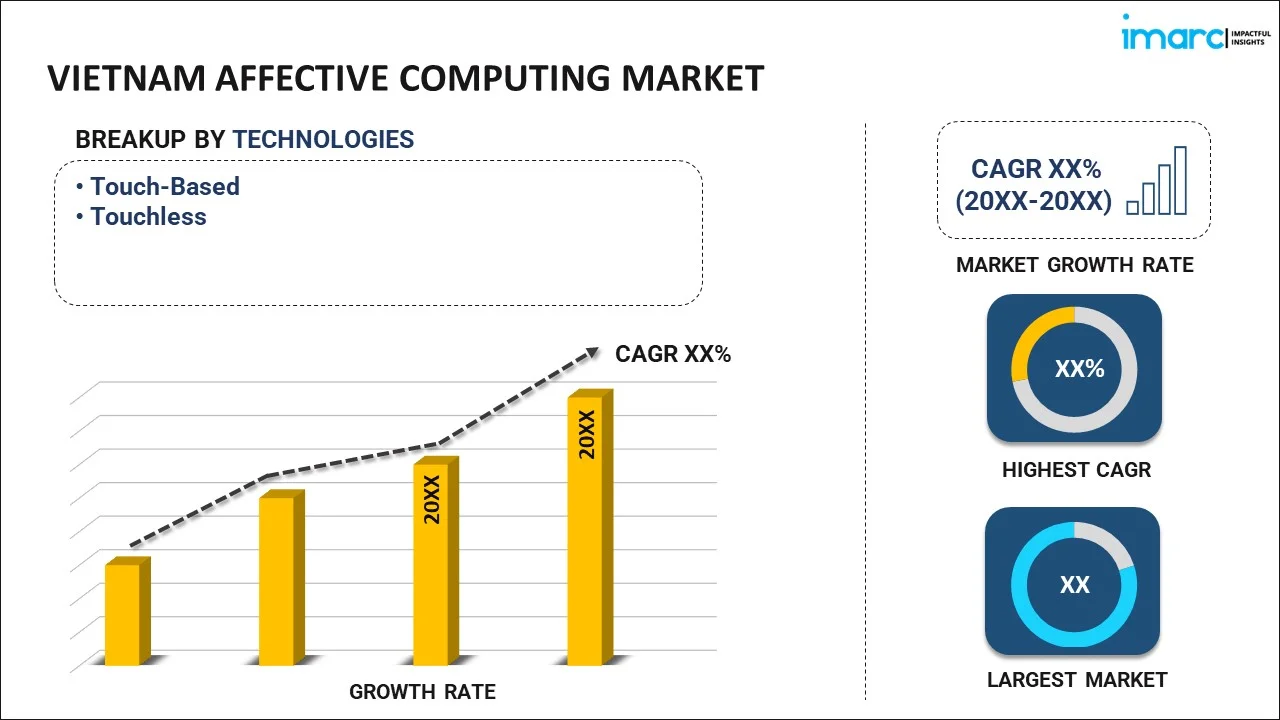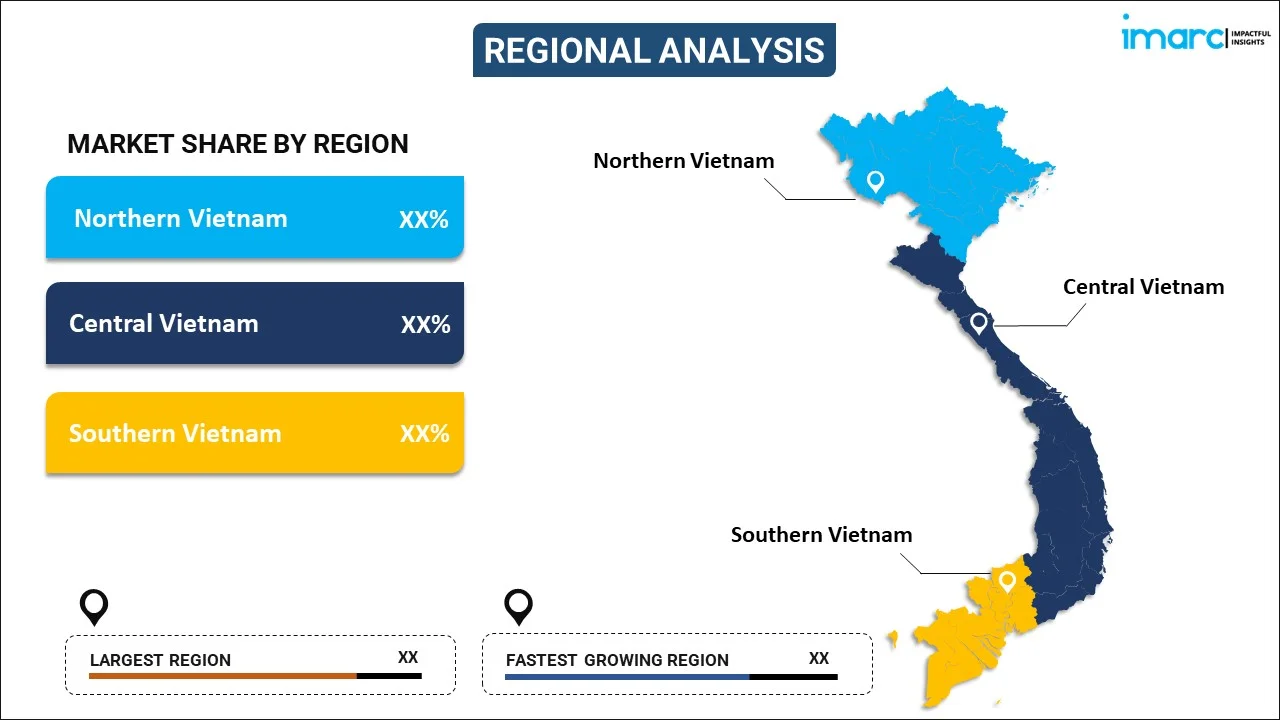
Vietnam Affective Computing Market Report by Technology (Touch-Based, Touchless), Component (Hardware, Software), End Use (Automotive, BFSI, Government, Healthcare, IT and Telecom, and Others), and Region 2025-2033
Market Overview:
Vietnam affective computing market size reached USD 352.0 Million in 2024. Looking forward, IMARC Group expects the market to reach USD 2,289.3 Million by 2033, exhibiting a growth rate (CAGR) of 23.13% during 2025-2033. The growing demand for personalized user experiences and the recognition of emotional intelligence as a critical element in human-computer interaction, rising advancements in deep learning algorithms and neural networks, and increasing popularity of virtual assistants represent some of the key factors driving the market.
|
Report Attribute
|
Key Statistics
|
|---|---|
|
Base Year
|
2024 |
|
Forecast Years
|
2025-2033
|
|
Historical Years
|
2019-2024
|
| Market Size in 2024 | USD 352.0 Million |
| Market Forecast in 2033 | USD 2,289.3 Million |
| Market Growth Rate (2025-2033) | 23.13% |
Affective computing involves the design and development of systems and devices that can recognize, interpret, and respond to human emotions. It comprises facial expression analysis, which involves the use of computer vision techniques to analyze facial expressions and infer emotional states. It also consists of speech and voice analysis, which can analyze the tone, pitch, and other features of speech to determine the emotional state of the speaker. It includes physiological signals, such as heart rate, skin conductance, and electroencephalogram (EEG) signals, which provide additional information about a person. It aims to bridge the gap between human emotions and computers, enabling more natural and emotionally intelligent interactions between users and technology. It can be incorporated into stress management applications to provide users with feedback and strategies for emotional well-being. Affective computing improves the user experience by making interactions with technology more natural and responsive. It can be personalized to better meet individual needs and preferences. It can lead to improved products, services, and customer relations, ultimately contributing to business success. Affective computing can be employed in educational settings to gauge the emotional responses of students, adapting learning materials accordingly.
Vietnam Affective Computing Market Trends:
At present, the increasing demand for personalized user experiences and the recognition of emotional intelligence as a critical element in human-computer interaction represents one of the crucial factors impelling the growth of the market in Vietnam. Besides this, the rising advancements in deep learning algorithms and neural networks are enabling computers to analyze and understand human emotions with more accuracy. This also paves the way for the integration of emotion-aware applications in various industries. In addition, the growing popularity of wearables equipped with biometric sensors to capture physiological signals indicative of emotional states, such as heart rate variability and skin conductance, is offering a favorable market outlook in the country. The seamless integration of these devices with affective computing technologies is also allowing for real-time monitoring and analysis of user emotions. Apart from this, the increasing popularity of virtual assistants, which can understand and respond to user emotions and deliver personalized content recommendations based on emotional states, is contributing to a more empathetic and user-centric approach to product and service design. Businesses are also realizing the importance of delivering emotionally intelligent interactions to build stronger connections with their users. Additionally, the rising employment of affective computing in areas, such as mental health monitoring, where emotion recognition can assist in the early detection of mood disorders, is supporting the market growth. Affective computing is also used to develop virtual companions that can provide emotional support to individuals dealing with mental health challenges. Moreover, key market players are working towards establishing ethical guidelines and standards to ensure that affective computing technologies are deployed in a manner that respects user rights and maintains trust.
Vietnam Affective Computing Market Segmentation:
IMARC Group provides an analysis of the key trends in each segment of the market, along with forecasts at the country level for 2025-2033. Our report has categorized the market based on technology, component, and end use.
Technology Insights:

- Touch-Based
- Touchless
The report has provided a detailed breakup and analysis of the market based on the technology. This includes touch-based and touchless.
Component Insights:
- Hardware
- Sensors
- Cameras
- Storage Devices and Processors
- Others
- Software
- Analytics Software
- Enterprise Software
- Facial Recognition
- Gesture Recognition
- Speech Recognition
A detailed breakup and analysis of the market based on the component have also been provided in the report. This includes hardware (sensors, cameras, storage devices and processors, and others) and software (analytics software, enterprise software, facial recognition, gesture recognition, and speech recognition).
End Use Insights:
- Automotive
- BFSI
- Government
- Healthcare
- IT and Telecom
- Others
The report has provided a detailed breakup and analysis of the market based on the end use. This includes automotive, BFSI, government, healthcare, IT and telecom, and others.
Regional Insights:

- Northern Vietnam
- Central Vietnam
- Southern Vietnam
The report has also provided a comprehensive analysis of all the major regional markets, which include Northern Vietnam, Central Vietnam, and Southern Vietnam.
Competitive Landscape:
The market research report has also provided a comprehensive analysis of the competitive landscape. Competitive analysis such as market structure, key player positioning, top winning strategies, competitive dashboard, and company evaluation quadrant has been covered in the report. Also, detailed profiles of all major companies have been provided.
Vietnam Affective Computing Market Report Coverage:
| Report Features | Details |
|---|---|
| Base Year of the Analysis | 2024 |
| Historical Period | 2019-2024 |
| Forecast Period | 2025-2033 |
| Units | Million USD |
| Scope of the Report | Exploration of Historical and Forecast Trends, Industry Catalysts and Challenges, Segment-Wise Historical and Predictive Market Assessment:
|
| Technologies Covered | Touch-Based, Touchless |
| Components Covered |
|
| End Uses Covered | Automotive, BFSI, Government, Healthcare, IT and Telecom, Others |
| Regions Covered | Northern Vietnam, Central Vietnam, Southern Vietnam |
| Customization Scope | 10% Free Customization |
| Post-Sale Analyst Support | 10-12 Weeks |
| Delivery Format | PDF and Excel through Email (We can also provide the editable version of the report in PPT/Word format on special request) |
Key Questions Answered in This Report:
- How has the Vietnam affective computing market performed so far and how will it perform in the coming years?
- What has been the impact of COVID-19 on the Vietnam affective computing market?
- What is the breakup of the Vietnam affective computing market on the basis of technology?
- What is the breakup of the Vietnam affective computing market on the basis of component?
- What is the breakup of the Vietnam affective computing market on the basis of end use?
- What are the various stages in the value chain of the Vietnam affective computing market?
- What are the key driving factors and challenges in the Vietnam affective computing?
- What is the structure of the Vietnam affective computing market and who are the key players?
- What is the degree of competition in the Vietnam affective computing market?
Key Benefits for Stakeholders:
- IMARC’s industry report offers a comprehensive quantitative analysis of various market segments, historical and current market trends, market forecasts, and dynamics of the Vietnam affective computing market from 2019-2033.
- The research report provides the latest information on the market drivers, challenges, and opportunities in the Vietnam affective computing market.
- Porter's five forces analysis assist stakeholders in assessing the impact of new entrants, competitive rivalry, supplier power, buyer power, and the threat of substitution. It helps stakeholders to analyze the level of competition within the Vietnam affective computing industry and its attractiveness.
- Competitive landscape allows stakeholders to understand their competitive environment and provides an insight into the current positions of key players in the market.
Need more help?
- Speak to our experienced analysts for insights on the current market scenarios.
- Include additional segments and countries to customize the report as per your requirement.
- Gain an unparalleled competitive advantage in your domain by understanding how to utilize the report and positively impacting your operations and revenue.
- For further assistance, please connect with our analysts.
 Inquire Before Buying
Inquire Before Buying
 Speak to an Analyst
Speak to an Analyst
 Request Brochure
Request Brochure
 Request Customization
Request Customization




.webp)




.webp)












